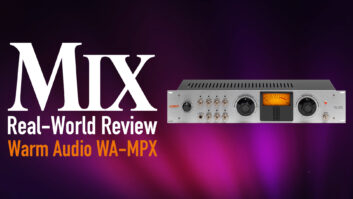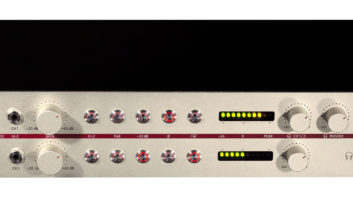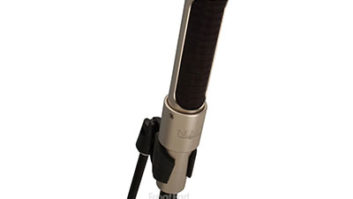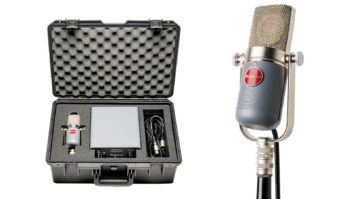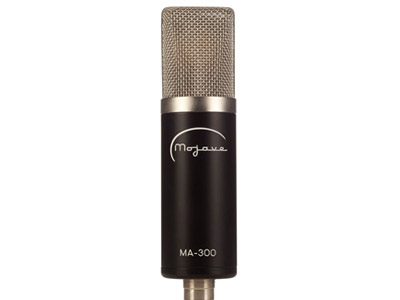
The sixth model in a growing line of microphones, Mojave Audio’s MA-300 comes from the mind of David Royer, a stickler for details. Just after Mojave released its first product, Royer told me about the difficulties of producing a mic long-distance (the units are built in China) and said that although he would painstakingly map out production details, he later found some elements had been changed, even in a small way.
For instance, an extra inch of wire was used from point to point—or some other detail was altered—and he wasn’t too happy about it. He returned the early production test models and made sure subsequent attempts closely followed the design spec before he approved the final build. It’s this kind of attention to detail that makes or breaks a product, especially when it’s manufactured 6,000 miles and 15 time zones away. For this reason the Mojave line has picked up some serious street cred. The pair of MA-300s tested here were used on a wide variety of instruments and vocals and sounded great across the board.
THE BODY AND BUILD
Everything about the physical product is top-notch. Packaging is excellent, offering more than enough protection for the mic and accessories. The shock-mount is sturdy and offers a good range of adjustability. It was easy to set up and place the mic in all applications. The cable from the mic to power supply is a well-made seven-pin XLR.
The MA-300’s two capsules are 3 microns thick and based on the design of Mojave’s MA-200. Rather than a stepped pattern selector, the MA-300 offers a continuously variable, remotely controlled pattern control between omni and figure-8. This is always welcome in a multipattern mic because it offers infinite possibilities in the amount of room you let into your recording. Too much room spill? Dial it back toward figure-8. Want more room vibe? Head toward omni.
The build inside is based around a military-grade JAN 5840 vacuum tube and Jensen transformer. Before coming to market, each mic, power supply and cable is burned in for 24 hours, tested, and then packed and shipped in a sturdy outer briefcase that contains the mic (housed in yet another latching hard shell case), power supply, cable and shockmount.
MA-I USE YOU?
Whenever I get a pair of mics for review, I like to hear them over a drum kit and piano right off the bat. Placed as overheads over a kit, the MA-300s rendered transients beautifully, with an even and pleasant balance of lows, mids and highs. You can definitely hear the tube and how it beefs up the low-mids and bottom. Cymbals are nicely reproduced, with clear stick hits and open highs without hype. Tom hits, kick and snare are well-represented, and the room is also brought into play as the pattern selector is rotated closer to omni.
The mics fared equally well over a Yamaha C3 piano. The piano sounded warm and natural, with tight transients and even tone that was never strident, even when played hard. The pattern adjustment let me dial in more or less spill from the lid and room, making for handy adjustments on-the-fly as other players were added to the mix.

The MA-300 ships in a sturdy briefcase that contains the mic, cable, power supply and shock-mount.
I heard the MA-300 placed just off-center of the speakers of a Fender Supersonic guitar amp. I also placed an SM57 and Sterling ST6050 Allen Sides Edition in relatively similar positions. As I expected, the MA-300 had much more bottom than the 57, which rolls off naturally starting at about 150 Hz. The Sterling sounded very good in the upper mids and highs, but didn’t have the beefy vocal, the mic offered plenty of body and even representation of the singer’s range. I would probably add a bit of top end for a mix but not a lot. There’s a pleasant midrange that particularly flattered this singer; that can be harder to capture with “cleaner” mics. Sibilance was not a problem, and the mic sounded good even when the singer drifted a bit off-axis. It seems like the cardioid pattern offers some tonal forgiveness when not directly on-axis: it sounds great at zero or up to 30 degrees left and right.
This mic wouldn’t be my first choice for certain hand percussion. It has the wrong personality for accurate and clinical applications; I prefer a super-clean condenser or a ribbon depending on the instrument. For me, a tube mic is too gritty for high percussion that needs the clarity of an FET or ribbon through a good-quality preamp. For instance, when used to record tambourine, the MA-300 sounded fine. I rolled off the bottom and ended up with a track that sat nicely with the drums and other percussion. But on triangle and VibraTone, the upper range was better represented by the AEA KU4 or Sterling ST6050 Allen Sides Edition through an SSL G Series console preamp.
DO YOU WANT MO-JAVE
? The Mojave MA-300 is a great mic at a price that may not fit every budget, especially since they work well as a pair. That said, you get what you pay for. It is well-made and tested, and comes with quality accessories and packaging. And as insurance, it’s made under the watchful eye of David Royer. Sonically, the MA-300 delivers, bringing its wonderful tube-y personality and great transient response to any recording. It’s a great go-to mic for vocals, drums, guitar amp, acoustic guitar and more.
Kevin Becka is Mix’s technical editor.

